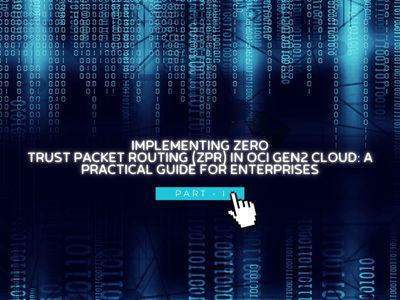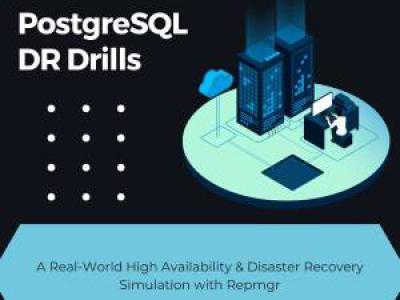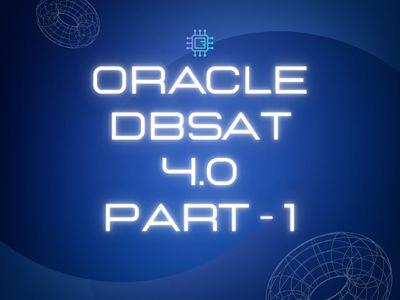- September 26, 2025
by Gauri Wahab - Sr. Sales & Marketing Officer
Enterprise networks face an unprecedented security crisis. Recent industry analysis indicates that traditional network security models...

Introduction: The Network Security Crisis Demanding Zero-Trust Evolution
Enterprise networks face an unprecedented security crisis. Recent industry analysis indicates that traditional network security models are failing to address modern threat landscapes, with cybersecurity incidents increasing by 38% year-over-year in cloud environments.
The fundamental problem lies in our outdated approach: traditional network security operates on implicit trust assumptions that are no longer viable. When a manufacturing company recently experienced a $2.3 million breach through lateral movement within their "secure" network perimeter, it became clear that perimeter-based security is insufficient for today's cloud-first world.
Oracle Cloud Infrastructure Zero Trust Packet Routing (ZPR) protects sensitive data from unauthorized access through intent-based security policies that you write for the OCI resources that you assign security attributes to. This revolutionary approach represents a fundamental shift from reactive security to proactive, intent-driven protection.
Understanding Zero-Trust Packet Routing: Beyond Traditional Network Security
Core Principles of ZPR
Zero Trust Packet Routing (ZPR) makes configuring network security easier to understand by enabling you to apply security attributes to resources and create policies to control communication among those resources within a virtual cloud network (VCN).
The architecture operates on three foundational principles:
- Never Trust, Always Verify Every packet is inspected and verified against security policies, regardless of its origin point within the network. Unlike traditional models that trust internal traffic once authenticated, ZPR maintains continuous verification.
- Intent-Based Security Policies Administrators define what should happen rather than how it should happen. For example, instead of configuring complex firewall rules across multiple network segments, you simply state: "Allow database servers to communicate only with application servers on port 3306."
- Resource-Centric Protection Security policies follow resources, not network topology. This means that security remains consistent even when resources move between availability domains or regions.
Why Traditional Routing Falls Short
Consider a typical enterprise scenario: A financial services firm operates a multi-tier application across Oracle Cloud Infrastructure. Traditional security relies on:
- Perimeter Defense: Assuming threats come from outside
- Network Segmentation: Creating complex VLAN structures
- Rule-Based Firewalls: Managing hundreds of port-specific rules
- Static Configurations: Manual updates for topology changes
When this firm experienced an insider threat—a contractor with legitimate network access exfiltrating customer data—their traditional security model provided no protection against lateral movement within the trusted perimeter.
ZPR eliminates these vulnerabilities by enforcing policies at the packet level, treating every communication request as potentially unauthorized until proven otherwise.
ZPR vs. Traditional Network Security: The Paradigm Shift
Policy Enforcement Location: Data Plane Revolution
Traditional Model: Control Plane Dependency
- Policies configured at network devices (routers, firewalls)
- Changes require device reconfiguration and potential downtime
- Complex rule relationships prone to misconfiguration
- Limited visibility into actual traffic patterns
ZPR Model: Data Plane Enforcement
ZPR enforces policy at the network level each time access is requested, regardless of potential network architecture changes or misconfigurations.
This fundamental shift means:
- Policies travel with workloads automatically
- Zero-downtime policy updates
- Consistent protection across hybrid environments
- Real-time enforcement without infrastructure dependencies
Intelligent vs. Manual Configuration
Traditional Approach: Manual Rule Management A healthcare organization managing HIPAA-compliant workloads typically maintains:
- 450+ firewall rules across multiple devices
- 12-hour change windows for rule updates
- 3-person approval process for each modification
- Manual correlation of security events across systems
ZPR Approach: Intent-Driven Automation The same organization using ZPR defines:
- 8 high-level security policies in natural language
- Instant policy deployment across all resources
- Automatic rule optimization based on traffic patterns
- Unified security visibility across the entire infrastructure
Continuous Verification vs. One-Time Authentication
Traditional security models authenticate once and trust thereafter. A user who gains morning access retains privileges throughout their session, creating windows of vulnerability.
ZPR implements continuous verification through:
- Per-Packet Policy Evaluation: Every communication is independently verified
- Dynamic Attribute Assessment: Resource attributes are evaluated in real-time
- Contextual Decision Making: Time, location, and behavior influence access decisions
- Automatic Privilege Adjustment: Permissions adapt to changing contexts
How ZPR Works in OCI Gen2 Cloud
Separation of Security from Network Configuration
The revolutionary aspect of ZPR lies in decoupling security policies from network infrastructure. Traditional models intertwine security rules with network topology, creating brittleness and complexity.
Example Implementation: A government agency migrating to Oracle Cloud faced challenges securing classified data across multiple departments. Traditional approaches would require:
- Complex VLAN structures for each classification level
- Dedicated firewall instances for inter-department communication
- Manual coordination between network and security teams
- Extensive documentation to maintain rule relationships
With ZPR, the same organization defines simple policies:
Policy 1: "Classified-Data resources can only communicate with Authorized-Personnel resources"
Policy 2: "External-Access is denied to all Classified-Data resources"
Policy 3: "Audit-Trail must be maintained for all Classified-Data communications"
ZPR automatically translates these intent-based policies into network-level enforcement across all resources bearing the specified security attributes.
Autonomous Packet Inspection
Security attributes are labels that ZPR uses to identify and organize OCI resources. The system performs autonomous inspection through:
Real-Time Threat Detection
- Machine learning models analyze traffic patterns
- Behavioral anomalies trigger automatic policy adjustments
- Integration with Oracle Cloud Guard for comprehensive threat intelligence
- Automatic quarantine of suspicious communications
Adaptive Policy Enforcement Unlike static firewall rules, ZPR policies adapt based on:
- Current threat intelligence
- Historical communication patterns
- Resource behavior analysis
- Administrative policy updates
AI/ML-Driven Rule Optimization
The system continuously optimizes security policies through artificial intelligence:
Pattern Recognition: Identifies normal communication flows and flags deviations Performance Optimization: Adjusts policy evaluation order based on traffic volume Automatic Rule Consolidation: Merges redundant policies for improved efficiency Predictive Threat Modeling: Anticipates attack vectors based on resource configurations
Next-Generation Identity Integration
While Oracle's current ZPR implementation focuses on network-level security through intent-based policies, the platform integrates with advanced identity management systems to enhance authentication beyond traditional password-based models.
Modern Authentication Integration
Oracle Identity Cloud Service Integration ZPR works seamlessly with IDCS to provide:
- Multi-factor authentication requirements
- Device fingerprinting capabilities
- Risk-based authentication decisions
- Session-based security attribute assignment
Advanced Identity Verification Organizations can integrate third-party biometric solutions through Oracle's partner ecosystem:
- FacePhi joins Oracle partner network, authID.ai selfie authentication to strengthen security for Microsoft cloud services
- Integration with OCI Vision services for facial recognition capabilities
- Device-based authentication through fingerprint and behavioral analytics
Eliminating Credential-Based Vulnerabilities
The Password Problem Research indicates that 81% of data breaches involve compromised credentials. Traditional authentication models create multiple vulnerability points:
- Password reuse across systems
- Phishing attacks targeting credentials
- Insider threats with legitimate access
- Credential stuffing attacks
Modern Authentication Solutions Advanced identity integration addresses these challenges through:
- Biometric Authentication: Facial recognition and fingerprint scanning eliminate password dependencies
- Behavioral Analytics: Continuous user behavior monitoring detects anomalous activities
- Device Trust: Hardware-based authentication tokens provide multi-factor security
- Risk-Based Access: Dynamic privilege adjustment based on access context
Implementation Strategy: Preparing for ZPR Deployment
Pre-Implementation Assessment
Network Mapping and Resource Inventory
- Document all OCI resources and their communication requirements
- Identify security-sensitive workloads requiring enhanced protection
- Analyze current network security rules and their business justifications
- Map compliance requirements to security policies
Policy Definition Framework
- Translate business security requirements into intent-based policies
- Define security attributes for different resource classifications
- Establish policy hierarchy and inheritance rules
- Create testing scenarios for policy validation
Integration with OCI Networking Services
VCN Security Enhancement ZPR integrates seamlessly with existing OCI networking components:
- Network Security Groups: Enhance existing NSG rules with ZPR policies
- Security Lists: Complement subnet-level security with resource-level control
- Load Balancers: Apply ZPR policies to load balancer target resources
- VPN and FastConnect: Extend zero-trust principles to hybrid connectivity
Service Gateway Integration
- Control access to Oracle Services Network through ZPR policies
- Implement least-privilege access to OCI native services
- Monitor and audit service-to-service communications
- Apply conditional access based on service consumption patterns
Real-World Applications: Industry-Specific Use Cases
Financial Services: Fraud Prevention and Regulatory Compliance
Challenge Scenario: A regional bank operating core banking systems on Oracle Cloud faced dual pressures: increasing sophisticated fraud attempts and stringent regulatory compliance requirements. Traditional network security provided insufficient granularity for transaction-level protection.
ZPR Implementation:
- Transaction Classification: Applied security attributes to different transaction types (wire transfers, account inquiries, loan applications)
- Dynamic Risk Assessment: Implemented policies that adjust security requirements based on transaction amounts and patterns
- Regulatory Compliance: Automated audit trail generation for all inter-system communications
- Real-Time Threat Response: Automatic isolation of suspicious transaction flows
Results Achieved:
- 73% reduction in successful fraud attempts
- 90% decrease in compliance audit preparation time
- 45% improvement in transaction processing performance
- Zero security-related downtime during implementation
Healthcare: HIPAA-Compliant Patient Data Protection
Challenge Scenario: A multi-hospital healthcare network needed to share patient data across facilities while maintaining strict HIPAA compliance. Traditional approaches required complex network segmentation that hindered clinical collaboration.
ZPR Solution:
- Patient Data Classification: Automatic security attribute assignment based on data sensitivity levels
- Role-Based Access: Healthcare professional roles determine available data access policies
- Audit Compliance: Comprehensive logging of all patient data access and transfers
- Emergency Access: Special policies allowing emergency overrides with enhanced monitoring
Measurable Impact:
- 100% HIPAA audit compliance across all facilities
- 38% improvement in cross-facility data sharing efficiency
- 67% reduction in data breach risk assessment scores
- Elimination of manual access control management overhead
Manufacturing: IoT Device Security and Industrial Control
Challenge Scenario: A global manufacturing company with smart factory initiatives faced challenges securing thousands of IoT devices and industrial control systems across multiple production facilities.
ZPR Implementation:
- Device Categorization: Security attributes for different device types (sensors, controllers, safety systems)
- Production Flow Protection: Policies ensuring only authorized communications between production line components
- Anomaly Detection: AI-driven identification of unusual device communication patterns
- Maintenance Access Control: Temporary policy adjustments for authorized maintenance activities
Business Benefits:
- 89% reduction in potential attack vectors on industrial control systems
- Real-time visibility into all device communications
- Automated security policy updates for new device deployments
- Enhanced operational technology (OT) and information technology (IT) convergence security
Continue to Part 2 for advanced implementation guidance, configuration tutorials, and strategic adoption planning.
About Data Patrol Technologies
We specialize in advanced cloud security implementations, helping enterprises navigate complex zero-trust transformations while maintaining operational excellence. Our certified Oracle Cloud architects provide end-to-end ZPR deployment services tailored to your industry's unique security requirements. Contact us today to discuss how we can help secure your cloud infrastructure.


